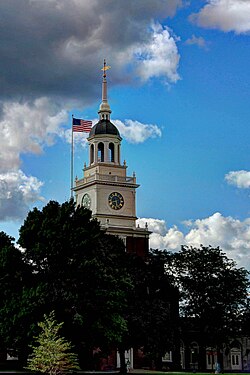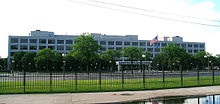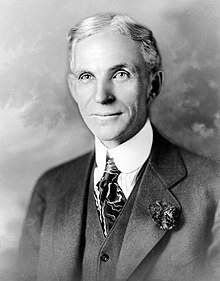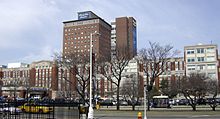The Henry Ford (also known as the Henry Ford Museum and Greenfield Village, and more formally as the Edison Institute) is a large indoor and outdoor history museum complex and a National Historic Landmark in the Metro Detroit suburb of Dearborn, Michigan, USA. Named for its founder, the noted automobile industrialist Henry Ford, and based on his desire to preserve items of historical significance and portray the Industrial Revolution, the property houses a vast array of famous homes, machinery, exhibits, and Americana. The collection contains many rare exhibits including John F. Kennedy's presidential limousine, Abraham Lincoln's chair from Ford's Theatre, Thomas Edison's laboratory, the Wright Brothers' bicycle shop, and the Rosa Parks bus.
Henry Ford said of his museum:
I am collecting the history of our people as written into things their hands made and used.... When we are through, we shall have reproduced American life as lived, and that, I think, is the best way of preserving at least a part of our history and tradition...
History

The Edison Institute was dedicated by President Herbert Hoover to Ford's longtime friend Thomas Edison on October 21, 1929 â€" the 50th anniversary of the first successful incandescent light bulb. Of the 260 people in attendance, some of the more famous were Marie Curie, George Eastman, John D. Rockefeller, Will Rogers, and Orville Wright. The dedication was broadcast on radio with listeners encouraged to turn off their electric lights until the switch was flipped at the Museum.
The Edison Institute was originally composed of the Henry Ford Museum, Greenfield Village, and the Greenfield Village Schools (an experimental learning facility). Initially, Greenfield Village and the Henry Ford Museum were owned by the Ford Motor Company which cooperates with the Henry Ford to provide the Ford Rouge Factory Tour and is a sponsor of the school. The Henry Ford is sited between the Ford Dearborn test track and several Ford engineering buildings with which it shares the same style gates and brick fences.
In 1970, the museum purchased what it believed to be a 17th-century Brewster Chair, created for one of the Pilgrim settlers in the Plymouth Colony, for $9,000. In September 1977, the chair was determined to be a modern forgery created in 1969 by Rhode Island sculptor Armand LaMontagne. The museum retains the piece as an educational tool on forgeries.
Henry Ford Museum
Henry Ford Museum began as Henry Ford's personal collection of historic objects, which he began collecting as far back as 1906. Today, the 12 acre (49,000 m²) site is primarily a collection of antique machinery, pop culture items, automobiles, locomotives, aircraft, and other items:
- The museum features an IMAX Theater, which shows scientific, natural, or historical documentaries; as well as major feature films.
- A model of the nuclear-powered Ford Nucleon automobile
- An Oscar Mayer Wienermobile
- The 1961 Lincoln Continental, SS-100-X that President John F. Kennedy was riding in when he was assassinated
- The rocking chair from Ford's Theatre in which President Abraham Lincoln was sitting when he was shot
- George Washington's camp bed.
- A ten-person safety bicycle made in 1896
- A collection of several fine 17th and 18th century violins including a Stradivarius.
- Thomas Edison's alleged last breath in a sealed tube.
- Buckminster Fuller's prototype Dymaxion house.
- The bus on which Rosa Parks was riding to work when she was arrested for refusing to give up her seat, leading to the Montgomery Bus Boycott
- Igor Sikorsky's prototype helicopter.
- Fokker Trimotor airplane that flew the first flight over the North Pole.
- Bill Elliott's record-breaking race car clocking in at over 212 MPH at Talledega in 1987
- Fairbottom Bobs, the Newcomen engine
- A steam engine from Cobb's Engine House in England.
- The Automotive Hall of Fame, adjacent to the Henry Ford Museum.
- A working fragment of the original Holiday Inn "Great Sign"
- Behind the scenes, the Benson Ford Research Center uses the resources of The Henry Ford, especially the photographic, manuscript and archival material which is rarely displayed, to allow visitors to gain a deeper understanding of American people, places, events, and things. The Research Center also contains the Ford Motor Archives.
- To commemorate the 100th anniversary of the sinking of the RMS Titanic, the Henry Ford Museum exhibited a vast array of artifacts and media documenting the Titanic's voyage and demise. The exhibit was hosted from 31 March to 30 September 2012.
Greenfield Village

The Henry Ford is the largest indoor-outdoor museum complex in America. Patrons enter at the gate, passing by the Josephine Ford Memorial Fountain and Benson Ford Research Center. Nearly one hundred historical buildings were moved to the property from their original locations and arranged in a "village" setting. The museum's intent is to show how Americans lived and worked since the founding of the country. The Village includes buildings from the 17th century to the present, many of which are staffed by costumed interpreters who conduct period tasks like farming, sewing and cooking. A collection of craft buildings such as pottery, glass-blowing, and tin shops provide demonstrations while producing materials used in the Village and for sale. Greenfield Village has 240 acres (970,000 m²) of land of which only 90 acres (360,000 m²) are used for the attraction, the rest being forest, river and extra pasture for the sheep and horses.
Village homes and buildings include:
- Noah Webster's Connecticut home, which served as a dormitory for Yale students from 1918 to 1936, when it was obtained by Henry Ford and moved to Greenfield Village where it was restored.
- The Wright brothers' bicycle shop and home, which was bought and moved by Henry Ford in 1937 from Dayton, Ohio.
- A replica of Thomas Edison's Menlo Park laboratory complex from New Jersey. Its reconstruction started in 1928. The buildings were laid out according to exact foundation measurements from the original site. It was furnished with original or faithful duplicates, all placed as they were originally.
- Henry Ford's birthplace, which was moved from Greenfield and Ford roads in 1944. Henry Ford had it furnished exactly as it was during his mother's time.
- Henry Ford's prototype garage where he built the Ford Quadricycle
- Harvey Firestone family farm from Columbiana, Ohio, which was given to the Village by Harvey's two remaining sons in 1983 to perpetuate their father's memory. It took over two years for the dissembling and rebuilding process and has been operated as a working sheep farm since 1985.
- The Logan County, Illinois courthouse where Abraham Lincoln practiced law
- William Holmes McGuffey's birthplace
- Luther Burbank's office
- Ackley Covered Bridge, a 75' wooden covered bridge, built in 1832 over Enlow Fork along the Greene - Washington County line in Southwestern Pennsylvania and removed to the village in 1937.
- Cape Cod Windmill, also known as the Farris mill, is considered one of the oldest in America. It was originally built in 1633 on the north side of Cape Cod. It was moved several times around Cape Cod until it was gifted to Henry Ford from the Ford Dealers Association, and installed in Greenfield Village in 1936.
A transportation system provides rides by horse-drawn omnibus, steam locomotive, a 1931 Model AA bus (one of about 15 known to exist), and authentic Ford Model Ts. The Weiser Railroad is a standard gauge passenger train that travels around the perimieter of Greenfield Village and has four stations. Steam locomotives in operation include the Torch Lake, an 1873 0-6-4 Mason Bogie which is one of the oldest operating steam locomotives in the U.S., and the Edison, a Manchester 0-4-0 rebuilt into a 4-4-0 by Ford. The railroad, unusual for a heritage railway, has a direct connection with tracks of the Norfolk Southern Railroad used by Amtrak trains between Chicago and Detroit, with a conditional station reserved for tour groups.
Signature events
Civil War Remembrance
Each year the Village honors the sacrifices and achievements of those who bravely fought in the American Civil War. The Civil War Remembrance takes place towards the end of May every year. An estimated 750,000 people died during the Civil War, which is equivalent to 7.5 million people today. The Civil War Remembrance is a weekend event, which includes, hundreds of Union and Confederate reenactors, musicians and historic presenters. This event features more than 400 Civil War reenactors who spend the entire weekend in the Village. Greenfield Village provides many opportunities in order to learn about the Civil War: exhibits, presentations, battle reenactments, hands-on activities and Q&A with historians.
Motor Muster
Motor Muster is one of two car shows that take place annually in Greenfield Village. Motor Muster is traditionally held on Father's Day weekend. This event currently features cars built from 1932â€"1976, and features between 600â€"800 cars. Special attractions include car judging, and Pass in Review in which experts discuss highlights of the passing cars.
Discovery Camp
Every summer the Henry Ford has a Summer Discovery Camp. It takes place inside Greenfield Village and the Henry Ford Museum between June and August. It is for children in grades 2-9. Each grade level has a different theme and children who participate in the Discovery Camp have the opportunity to look at both the Henry Ford Museum and Greenfield Village from different perspectives. Children participate in activities such as: apprenticeships, canoeing, glass blowing and other age-dependent activities.
World Tournament of Historic Baseball
The World Tournament of Historical Baseball takes place every year in August. Guests get to take a step back in time to 1867 as vintage baseball clubs from around the country compete by the game’s early rules in a two-day exposition of historic baseball. The clubs engage in two days of throwing, batting and competition. The event is included in Greenfield Village admission.
Salute to America
For four nights around Independence Day, the Detroit Symphony Orchestra performs a patriotic concert on Walnut Grove in the Village. Attendance ranges from 5000â€"9500 per evening.
Ragtime Street Fair
This event was inaugurated in 2007 and returned in 2008. The Street Fair features several live performers along with recorded music from the Ragtime era (ca. 1900-1917). The 2008 event also featured silent movies and a vaudeville show in town hall as well as the 1912 presidential campaign of Theodore Roosevelt. Instruction in the ragtime one step is provided free of charge at this event.
Old Car Festival
The Old Car Festival takes place every year in September. The Old Car Festival has been held on the first weekend after Labor Day since 1955. The festival takes over the streets and grounds of Greenfield Village with the sights, sounds, and smells of hundreds of authentic vehicles from the 1890s through 1932. This event features 500-700 cars. Special events include car judging, Pass in Review, the gaslight tour, and car races on the Walnut Grove field. Guests can take a self-guided tour of the exposition and talk to the owners of the treasured vehicles. Visitors can watch a Model T be assembled in just minutes, attend presentations, and hear experts share information about the vintage vehicles.
Hallowe'en in Greenfield Village
The Village's Halloween celebration features decorations, a headless horseman, witches, other costumed characters, treats and activities for visitors. It is held Friday, Saturday and Sunday evenings in October.
Holiday Nights
The Christmas season has traditionally been very popular in Greenfield Village. Many buildings feature period decorations and evening tours are conducted along candle-lit paths. Visitors can view live entertainment and costumed presenters or ride in a horse-drawn carriage or Model T.
Rouge Tour

The Ford Rouge Factory Tour is a first-hand journey behind the scenes of a modern, working automobile factory. Boarding buses at the Henry Ford Museum, visitors are taken to the River Rouge Plant and Dearborn Truck Plant â€" an industrial complex where Ford has built cars since the Model A and which once employed 100,000 people.
In 2003, the Ford Rouge Factory, the manufacturing facility for Ford's Ford F-Series truck, reopened following extensive renovations. When it reopened in 2003, as sustainable architecture (Gold LEED Building) led by noted 'green' architect William McDonough, it also opened a new state-of-the-art visitor center highlighting not only the factory's sustainable aspects, but also educating visitors on the legacy of the historic manufacturing facility, as well as the vehicle manufacturing process that takes place within the manufacturing plant. The visitor experiences, designed by award winning experience designer Bob Rogers and the design team BRC Imagination Arts, offers two multi-screen theaters, numerous touchscreen interpretive displays and overlook the world’s largest “Green†roof, atop the factory. Visitors then walk through the working assembly plant.
Gallery

See also

- Architecture of metropolitan Detroit
- Automotive Hall of Fame
- The Dearborn Inn
- Fair Lane (Henry Ford's estate)
- Greenfield Village (Amtrak station)
- Henry Ford Academy
- Tourism in metropolitan Detroit
- Blab school
References

Further reading

- Bryan, Ford R. (1996). Henry's Attic: Some Fascinating Gifts to Henry Ford and His Museum. Wayne State University Press. ISBNÂ 978-0814326428.Â
- Cantor, George (2005). Detroit: An Insiders Guide to Michigan. University of Michigan Press. ISBNÂ 0-472-03092-2.Â
- Fisher, Dale (2003). Building Michigan: A Tribute to Michigan's Construction Industry. Grass Lake, MI: Eyry of the Eagle Publishing. ISBNÂ 1-891143-24-7.Â
- Hill, Eric J. and John Gallagher (2002). AIA Detroit: The American Institute of Architects Guide to Detroit Architecture. Wayne State University Press. ISBNÂ 0-8143-3120-3.Â
- Meyer, Katherine Mattingly and Martin C.P. McElroy with Introduction by W. Hawkins Ferry, Hon A.I.A. (1980). Detroit Architecture A.I.A. Guide Revised Edition. Wayne State University Press. ISBNÂ 0-8143-1651-4.Â
External links

- The Henry Ford (Mobile)
- Greenfield Village Amtrak Station & Smith's Creek Depot(USA RailGuide -- Train Web)

